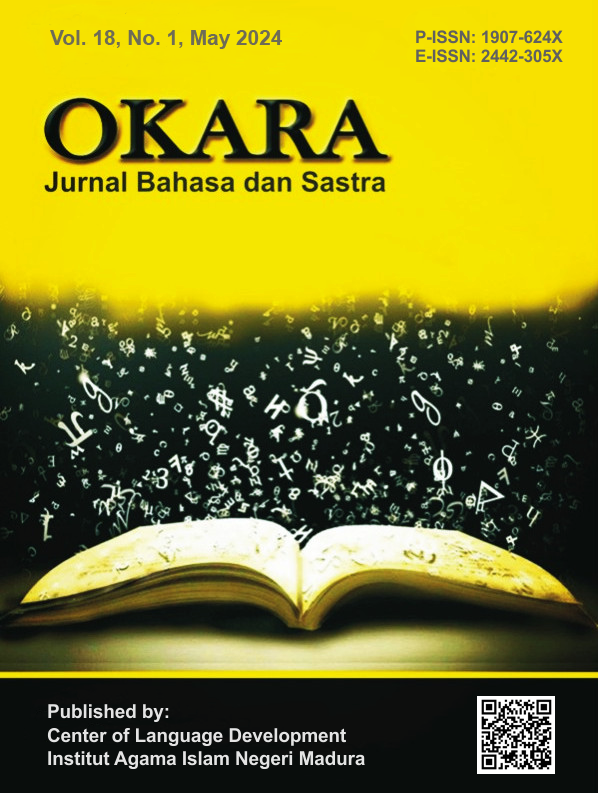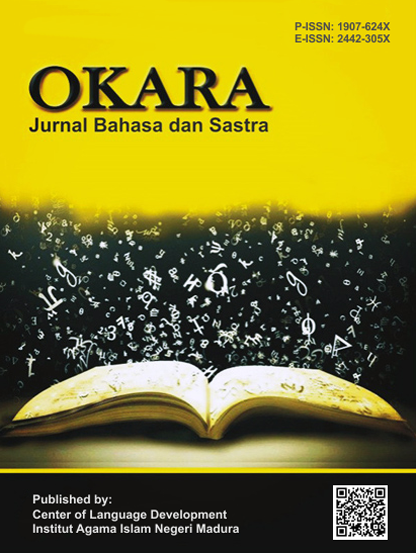Personal Deixis in the Madurese Translation of Surah Yaseen
 Abstract views: 381
,
Abstract views: 381
,
 PDF downloads: 382
PDF downloads: 382
Abstract
Accurately interpreting the Qur'an is always challenging, especially within the Madurese translation of Surah Yaseen. Given the linguistic intricacies and the cultural context of Madura's devout Muslim community and its Tahlil tradition, it is necessary to identify and understand personal deixis accurately to avoid misunderstandings and ensure faithful interpretation of the sacred text. This study focuses on various personal deixis in Madurese to identify its forms and references in Surah Yaseen. By employing a qualitative descriptive approach and observational method with advanced note-taking, the study scrutinizes verses bearing personal deixis in the Madurese translation. The research findings reveal several forms of personal deixis: Sèngko' (I/Allah), sèngko' (me/other than Allah), kaulâ (me), Sèngko' (We/Allah), sèngko' kabbhi (us/other than Allah), bâ'na (you), bâ'na kabbhi (all of you), (orèng) jâreya (him), and (rèng-orèng) jâreya (them). Those personal deixes refer to Allah, the Prophet Muhammad, the Arabs, residents of the land of Intakiyah, the apostles of Allah, the unbelievers, Habib an-Najar, and Allah's creatures. The researcher highlights the presence of the same personal deixis form, Sèngko', in both singular and plural first person in Madurese, referring to Allah, which may lead to confusion in comprehension, thus suggesting future translation teams distinguish between the singular and plural forms of "Sèngko'" to avoid confusion among readers.
Downloads
References
Abuisaac, S., Albasha, J., Ghaith, M., & Bin Sapar, A. (2023). Barriers of Intercultural Communication in Transferring Culturally-Bound Utterances and Expressions of the Qur’an from Arabic into English: Implications and Strategy. Journal of Intercultural Communication Research, 52(1), 1–24. https://doi.org/10.1080/17475759.2022.2137559
Ahmadi, R. (2015). Model Terjemahan Al-Qur’an Tafsiriyah Ustad Muhammad Thalib. Center of Middle Eastern Studies (CMES), 8(1), 57–69. https://doi.org/10.20961/CMES.8.1.11624
Ahya, A., & Ahya, A. S. (2018). Perubahan Referen dalam Penerjemahan Al-Quran ke dalam Bahasa Indonesia (Sebuah Telaah Semantik). SASTRANESIA: Jurnal Program Studi Pendidikan Bahasa dan Sastra Indonesia, 5(3). https://doi.org/10.32682/sastranesia.v5i3.754
Al-Hafiz, S. I., & Kasir, I. A. F. I. I. K. A. H. U. I. (2015). Tafsir Ibnu Katsir Surah Yasin. Jakarta: Shahih.
Al-Hamzi, A. M. S., Sumarlam, Santosa, R., & Jamal, M. (2023). A Pragmatic and Discourse Study of Common Deixis Used by Yemeni-Arab Preachers in Friday Islamic Sermons at Yemeni Mosques. Cogent Arts & Humanities, 10(1). https://doi.org/10.1080/23311983.2023.2177241
Al-Maliki, S. M. A. (2001). Keistimewaan-Keistimewaan Al-Qur’an. Yogyakarta: Mitra Pusaka.
Altohami, W. M. A., & Khafaga, A. (2023). Exploring the Referential Range of Etymologically-Related Lexical Pairs in the Language of the Qur’an: A Cognitive-Semantic Approach. Cogent Arts & Humanities, 10(1), 2185969. https://doi.org/10.1080/23311983.2023.2185969
Anwari, A., & Kurniawati, E. (2023). Penggunaan Tingkatan Bahasa Madura dan Kaidahnya oleh Masyarakat Madura di Probolinggo. Vilvatikta: Jurnal Pengembangan Bahasa dan Sastra Daerah, 1(2), 60–68. https://doi.org/10.59698/VILVATIKTA.V1I2.73
Aswan, A., Idris, N. S., & Widia, I. (2021). Perbandingan Pronomina Persona Bahasa Indonesia dengan Bahasa Malaysia: Tinjauan Semantis. Diksi, 29(2), 195–204. https://doi.org/10.21831/DIKSI.V29I2.43034
Burdah, I. (2004). Menjadi Penerjemah: Metode dan Wawasan Menerjemah Teks Arab. Yogyakarta: Tiara Wacana.
Cummings, L. (2007). Pragmatik: Sebuah Perspektif Multidisipliner (E. Setiawati, Ed.). Yogyakarta: Pustaka Pelajar.
Feng, B., Li, X., & Lin, L. (2021). Valenced Social Identities and the Digital Divide in Online Health Communities. Computers in Human Behavior, 122, 106812. https://doi.org/10.1016/j.chb.2021.106812
Ghali, M. M. (2008). Towards Understanding the Ever-Glorious Qur’an (5th edition). S.l.: Dar An-Nashr Liljami’at.
Ghozali, M., Mursyid, A. Y., & Fitriana, N. (2022). Al-Qur’an (Re)Presentation in the Short Video App Tiktok: Reading, Teaching, and Interpretive. Pertanika Journal of Social Sciences and Humanities, 30(3), 1263–1282. https://doi.org/10.47836/pjssh.30.3.18
Gunawan, F. (2022). The Ideology of Translators in Quranic Translation: Lessons Learned from Indonesia. Cogent Arts & Humanities, 9(1), 2088438. https://doi.org/10.1080/23311983.2022.2088438
Haryono, A. (2018). Communication Patterns among Kiais of Nahdlatul Ulama in the Madurese Ethnic Group. Indonesian Journal of Applied Linguistics, 7(3), 714–726. https://doi.org/10.17509/ijal.v7i3.9822
Hassanein, H. (2022). Translating Semantic Cases from Qur’anic Arabic into English. Journal of Intercultural Communication Research, 51(1), 58–78. https://doi.org/10.1080/17475759.2021.2001357
Herdiana, R., Al-Farisi, Z., & Khalik, A. (2022). Herdiana, R., Al-Farisi, Z., & Khalik, A. (2022). Perbandingan Penggunaan Deiksis Persona dalam Terjemahan Bahasa Indonesia dan Bahasa Inggris pada Surat Al-Qashash. Ta’lim al-’Arabiyyah: Jurnal Pendidikan Bahasa Arab & Kebahasaaraban, 6(1), 106–124. https://doi.org/10.15575/jpba.v6i1.16221
Ismail, A., & Solahuddin, A. (2023). Psychology of Patience and Semantic Approach to the Qur’an: Meaning of Qāla on Istirjā’ Verse. Cogent Arts & Humanities, 10(1), 2168342. https://doi.org/10.1080/23311983.2023.2168342
Jamilah, U. (2017). Deiksis dalam Terjemahan Al-Qur’an Surat Al-Baqarah Ayat 1 Sampai 286 (Bachelor Thesis, Universitas Muhammadiyah Surakarta). Universitas Muhammadiyah Surakarta. Retrieved from https://repository.ump.ac.id/4236/
Lailurrahman, Effendy, M. H., Dradjid, D., & Muakmam, M. (2022). Sorat Yasin Tarjama Bhasa Madhura. Pamekasan: Tim Pantarjama Yayasan Pakem Maddhu.
Lailurrahman, Hasan, Z., Zahid, Moh., Ghoffar, Abd., Latif, A. R. A., Kutwa, … Zaely, A. (2022). Ma’na Ma’nana Al-Qur’an Tarjamah Bhasa Madhura. Pamekasan: Lembaga Penerjemahan dan Pengkajian Al-Qur’an (LP2Q).
Mahsun. (2014). Metode Penelitian Bahasa: Tahapan Strategi, Metode, dan Tekniknya. Jakarta: Rajawali Press. Jakarta: Rajawali Pers.
Matsumoto, Y., Akita, K., & Takahashi, K. (2017). The Functional Nature of Deictic Verbs and The Coding Patterns of Deixis. In I. Ibarretxe-Antuñano (Ed.), Motion and Space Across Languages (pp. 95–122). Philadelphia: John Benjamins Publishing Company. https://doi.org/10.1075/hcp.59.05mat
Muakmam. (2009). Sorot Sandherrâ Caca Aghuna’aghi Onḍhâgghâ Bhâsa Madhurâ. Pamekasan.
Mufida, A. (2022). nalisis Wacana Aspek Kohesi Gramatikal Referen Terjemahan Alquran Surat At-Thalaq: Teknik dan Kualitas Penerjemahan. FASHOHAH : Jurnal Ilmiah Pendidikan Bahasa Arab, 2(1), 1–17. https://doi.org/10.33474/fsh.v2i1.13562
Muhammad, M. (2018). Dinamika Terjemah Al-Qur’an (Studi Perbandingan Terjemah Al-Qur’an Kemenerian Agama RI dan Muhammad Thalib). Jurnal Studi Ilmu-Ilmu Al-Qur’an dan Hadis, 17(1), 1–24. https://doi.org/10.14421/qh.2016.1701-01
Nagy, I. K. (2015). An Introduction to The Study of Pragmatics. Cluj-Napoca: Scientia Kiado.
Nofitasari. (2012). Deiksis Sosial dalam Novel Laskar Pelangi (Thesis, Universitas Negeri Surakarta). Universitas Negeri Yogyakarta. Retrieved from https://eprints.uny.ac.id/8371/
Nurtawab, E., & Adi Deswijaya, R. (2022). Verse Numbering System and Arabic References in Bagus Ngarpah’s Early 20th-Century Javanese Qurʾan. Indonesia and the Malay World, 50(147), 173–197. https://doi.org/10.1080/13639811.2022.2026619
Pangaribuan, R. E., Manik, S., & Pasaribu, T. (2015). Deixis Used on Business Brochures Text: A Pragmatics Study. International Journal of English Linguistics, 5(5), 171-182. https://doi.org/10.5539/IJEL.V5N5P171
Putri, N. A. (2017). Metafora Pengungkap Kecantikan dalam Masyarakat Madura. ETNOLINGUAL, 1(2), 73–99. https://doi.org/10.20473/ETNO.V1I2.7395
Qassem, M. (2021). Translations of Stylistic Variations in the Noble Qur’an into English: Stylistic and Exegetical Perspectives. Journal of Intercultural Communication Research, 50(3), 304–322. https://doi.org/10.1080/17475759.2020.1841016
Ramlah, S., Ni, &, Sartini, W., & Sartini, N. W. (2023). Strategy, Factor, and Response of Apologies in Javanese and Madurese: A Cross-Cultural Pragmatics Study. Cogent Arts & Humanities, 10(2), 2275341. https://doi.org/10.1080/23311983.2023.2275341
Rifa’, A., & Marhamah, M. (2020). The Method of Messenger of Allah in Al Qur’an Learning. Journal of Educational and Social Research, 10(3), 131–140. https://doi.org/10.36941/jesr-2020-0053
Romadlon, D. A., & Septi, D. (2020). Membenarkan Allah dalam Iman: Membaca Aqidah Dengan Nalar Kritis. Sidoarjo: Umsida Press.
Sardar, Z. (2017). Reading the Qur’an: The Contemporary Relevance of the Sacred Text of Islam. New York: Oxford University Press. Retrieved from https://press.umsida.ac.id/index.php/umsidapress/article/view/978-623-6833-40-7/720
Shiferaw, T. A. (2023). The Semantics and Pragmatics of Blessing Expressions in Rayya Tigrinya. Cogent Arts & Humanities, 10(2), 2275358. https://doi.org/10.1080/23311983.2023.2275358
Sobari, D. (2020). Analisis Penerjemahan Teks Berbahasa Arab dalam Buku Mahfuzhat: Kumpulan Kata Mutiara, Peribahasa Arab-Indonesia. Tamaddun: Jurnal Kebudayaan dan Sastra Islam, 20(2), 97–112. https://doi.org/10.19109/TAMADDUN.V20I2.6674
Sofyan, A. (2012). Beberapa Keunikan Linguistik Bahasa Madura. Humaniora, 19(3), 232–240. https://doi.org/10.22146/jh.1264
Sugiyono. (2017). Metode Penelitian Kuantitatif, Kualitatif, dan R&D. Bandung: CV. Alfabeta.
Tumanggor, I. (2018). Analisis Deiksis pada Al-Quran Surat Al-Kahfi (Thesis, Universitas Sumatera Utara). Universitas Sumatera Utara. Retrieved from https://repositori.usu.ac.id/handle/123456789/22039
Tumanggor, I., & Nasution, K. (2017). Deiksis Persona dalam Al-Quran Surat Al-Kahfi. WARAQAT: Jurnal Ilmu-Ilmu Keislaman, 2(2), 22–22. https://doi.org/10.51590/WARAQAT.V2I2.56
Winiharti, M. (2021). Tipologi Pronomina Persona dalam Bahasa Jawa, Sunda dan Madura. Ranah: Jurnal Kajian Bahasa, 10(2), 252–260. https://doi.org/10.26499/RNH.V10I2.2092
Yousefi, M., & Mardian, F. (2020). Analyzing Meaning: An Introduction to Semantics and Pragmatics. Australian Journal of Linguistics, 40(2), 270–272. https://doi.org/10.1080/07268602.2019.1680090
Yule, G. (2014). Pragmatik (Jumadi, Trans.). Yogyakarta: Pustaka Pelajar.
Zabidi, A. F. M., & Haqqi, Z. (2020). Pengenalan Awal Tafsir ‘Al-Quran Al-Karim dan Terjemahan Bebas Bersajak dalam Bahasa Aceh’ Karya Syeikh Mahjiddin Jusuf. The Sultan Alauddin Sulaiman Shah Journal (JSASS), 7(2), 146–160.
The journal operates an Open Access policy under a Creative Commons Attribution-NonCommercial 4.0 International License. Authors who publish with this journal agree to the following terms:
- Authors retain copyright and grant the journal right of first publication with the work simultaneously licensed under a Creative Commons Attribution License that allows others to share the work with an acknowledgement of the work's authorship and initial publication in this journal.
- Authors are able to enter into separate, additional contractual arrangements for the non-exclusive distribution of the journal's published version of the work (e.g., post it to an institutional repository or publish it in a book), with an acknowledgement of its initial publication in this journal.
- Authors are permitted and encouraged to post their work online (e.g., in institutional repositories or on their website) prior to and during the submission process, as it can lead to productive exchanges, as well as earlier and greater citation of published work.





_(1).png)
.png)
.png)
1.png)
.png)
.png)

.png)
_-_Copy_-_Copy.png)





